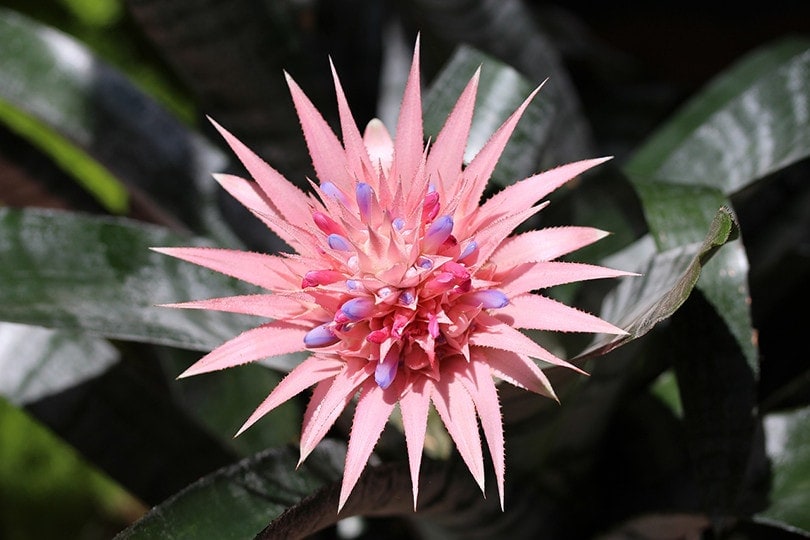Are Snake Plants Toxic to Dogs? Vet Reviewed Risks & Safe Alternatives
By Jordyn Alger
Updated on

Click to Skip Ahead
Snake plants are common house plants due to their easy maintenance and the minimal space they take up. However, if you have a dog in the home, avoiding this plant is in your best interest since snake plants are toxic to canines. Other names for the snake plant include Mother-in-Law’s Tongue, Good Luck Plant, and Golden Bird’s Nest, so if any of these plants are accessible to your dog, you need to remove them from his space as soon as possible.
If you are concerned that your dog has come in contact with a snake plant, watch for signs of toxicity. These signs include nausea, diarrhea, and vomiting. If you notice these signs, immediately contact your vet or a local veterinary emergency clinic.
Other Common Houseplants to Avoid
Snake plants are not the only dangerous houseplant for dogs. There are plenty of plants in the world that pose a risk to your pet, so it is recommended that you research each plant you look at before bringing it home. Below are some common houseplants that every dog owner should stay away from.
Zamioculcas Zamiifolia (ZZ Plant)
Many people enjoy ZZ plants because they are quick to grow and are not terribly picky. Since they are so easy to care for, they are remarkably common. They are also toxic to dogs and humans. So, whether you have a fur baby or an actual baby, staying away from the ZZ plant is best.
Lilies
Lilies are beautiful flowers. Unfortunately, they are also dangerous. Typically, lilies are more dangerous for cats than dogs, but there are still varieties that can be incredibly toxic for canines. These flowers can lead to tremors, depression, anorexia, and gastrointestinal upset.

Weeping Fig
Weeping figs emit a sap that is highly toxic to your pets. Dogs, cats, and even parakeets will experience significant irritation of the mouth and gastrointestinal tract if they ingest this plant. Even if they don’t eat it and the sap gets onto their skin, it can cause skin irritation.
 How to Keep Your Dog Safe from Toxic Plants
How to Keep Your Dog Safe from Toxic Plants
There’s no need to get rid of all of the greenery in your home. If you realize that you’ve been caring for a toxic plant, there are some ways that you can keep the plant and the pet at the same time.
Remove Plants from Your Dog’s Reach
Is there a room in your home that your dog is not allowed in? That could be the perfect place for any potentially dangerous plants. Keeping these plants out of your pet’s reach allows you to keep the plant while still ensuring your pet’s safety. Placing the plant on a high shelf can also be a way to remove it from your dog’s range. However, this may not work if your pet is especially rambunctious or prone to knocking things over. If that’s the case, simply removing the plant from your dog’s reach may not be enough.
Place Plants Inside a Decorative Cover
This option may be a bit unconventional, but it can add a unique flair to your home decorations. By placing these plants inside decorative holders, you can provide a safety barrier between your plant and your pet. Of course, this option is much more difficult for larger plants, so it may not work in every instance.
Remove the Plants from the Home
If neither of the previous options works for you, it may be time to say goodbye to the plant. It’s always sad to see something you’ve worked hard to cultivate disappear, but sometimes it is necessary.
However, this doesn’t always mean you have to remove the plant from your life entirely. If you have enough resources and outdoor space to construct an outdoor greenhouse, you could create your own space to house all the plants you want while keeping your furry friend safe.

Why Do Dogs Try to Eat Plants?
Our pets can be confusing at times. Why would a dog eat something dangerous? The answer is pretty simple; your dog doesn’t know what he is eating.
While we can tell the difference between dangerous and safe substances, our pets cannot. Dogs are naturally curious and may be inclined to munch on something they’ve never tasted before just to see what it is like.
 Common Houseplants That Are Safe for Pets
Common Houseplants That Are Safe for Pets
Just because some plants are dangerous for your dog doesn’t mean all plants are. There are still plenty of safe ways for you to spruce up your home with greenery.
Bromeliads
Bromeliads have unique shapes and colors that make them especially appealing as houseplants. They are easy to grow, resilient, and strong enough to handle damage if your dog accidentally knocks them over.

Money Tree
The money tree may not grow actual money, but the fact that it is safe for dogs may make it priceless to some.
Echeveria
Echeverias are succulents that don’t require much water, so if you forget to water it for a bit, it will be fine.

Final Thoughts
Snake plants may not be safe for dogs, but there are plenty of safe, low-maintenance plants that can be used as an alternative. No matter how safe the plant is, it is best to keep it out of your dog’s reach so that he doesn’t chew on it, thus damaging the plant and possibly giving himself a tummy ache. If you’re looking for plants to add to your household, examine the ASPCA’s list of non-toxic plants before visiting the nursery.
See Also:
- Are Ferns Toxic to Dogs? Vet-Approved Toxicity & Alternatives
- Are Asparagus Ferns Poisonous to Dogs? Vet-Reviewed Toxicity & Alternatives
Featured Image Credit: Tanuj_handa, Pixabay













